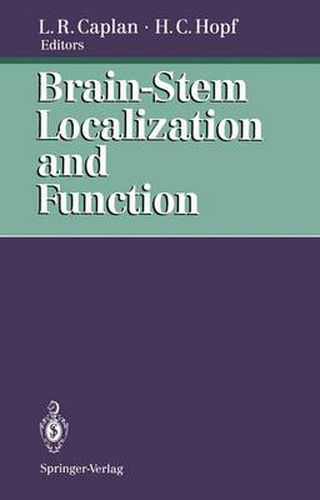Readings Newsletter
Become a Readings Member to make your shopping experience even easier.
Sign in or sign up for free!
You’re not far away from qualifying for FREE standard shipping within Australia
You’ve qualified for FREE standard shipping within Australia
The cart is loading…






This title is printed to order. This book may have been self-published. If so, we cannot guarantee the quality of the content. In the main most books will have gone through the editing process however some may not. We therefore suggest that you be aware of this before ordering this book. If in doubt check either the author or publisher’s details as we are unable to accept any returns unless they are faulty. Please contact us if you have any questions.
The brain stem and cerebellum are structures that have fascinated and puzzled physicians, anatomists, and physio- logists for centuries. Relatively small in volume compared to the much larger and more majestic human cerebrum, and hidden away in relative obscurity in the back of the head under the protection of the bony posterior fossa and the firm dural envelope, the tentorium cerebelli, these critical neural structures defied precise study during life until very recently. Recent advances in brain and vascular imaging and improved understanding of brain-stem reflex and tract functions and their measurement by electrophysiological techniques have presented an opportunity for clinicians and researchers to better study, during life, patients with stroke and other conditions that involve the brain stem and cere- bellum. A congress was held at the Neurology Clinic of the University in Mainz, April 4-5, 1992, during which clinicians and researchers reported and discussed modern topical diagnosis of diseases of the brain stem and cere- bellum. This volume represents the edited proceedings of that congress. Early information about brain stem anatomy and func- tions came from anatomical studies by Ludwig Turk, Paul Flechsig, Rudolph von K6lliker, Karl Burdach, Vladimir Bekterew, and Benedikt Stilling, among others, all working in Germany during the middle years of the nineteenth century. Johann Reil, a German anatomist, in the begin- ning of the nineteenth century had described the structure and some functions of the cerebellum which he called the little brain ( Kleinhirn ).
$9.00 standard shipping within Australia
FREE standard shipping within Australia for orders over $100.00
Express & International shipping calculated at checkout
This title is printed to order. This book may have been self-published. If so, we cannot guarantee the quality of the content. In the main most books will have gone through the editing process however some may not. We therefore suggest that you be aware of this before ordering this book. If in doubt check either the author or publisher’s details as we are unable to accept any returns unless they are faulty. Please contact us if you have any questions.
The brain stem and cerebellum are structures that have fascinated and puzzled physicians, anatomists, and physio- logists for centuries. Relatively small in volume compared to the much larger and more majestic human cerebrum, and hidden away in relative obscurity in the back of the head under the protection of the bony posterior fossa and the firm dural envelope, the tentorium cerebelli, these critical neural structures defied precise study during life until very recently. Recent advances in brain and vascular imaging and improved understanding of brain-stem reflex and tract functions and their measurement by electrophysiological techniques have presented an opportunity for clinicians and researchers to better study, during life, patients with stroke and other conditions that involve the brain stem and cere- bellum. A congress was held at the Neurology Clinic of the University in Mainz, April 4-5, 1992, during which clinicians and researchers reported and discussed modern topical diagnosis of diseases of the brain stem and cere- bellum. This volume represents the edited proceedings of that congress. Early information about brain stem anatomy and func- tions came from anatomical studies by Ludwig Turk, Paul Flechsig, Rudolph von K6lliker, Karl Burdach, Vladimir Bekterew, and Benedikt Stilling, among others, all working in Germany during the middle years of the nineteenth century. Johann Reil, a German anatomist, in the begin- ning of the nineteenth century had described the structure and some functions of the cerebellum which he called the little brain ( Kleinhirn ).